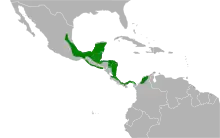Red-throated ant tanager
The red-throated ant tanager (Habia fuscicauda) is a medium-sized passerine bird. This species is a resident breeder on the Caribbean slopes from southeastern Mexico to eastern Panama. It was usually considered an aberrant kind of tanager and placed in the Thraupidae, but is actually closer to the cardinals (Cardinalidae). Consequently, it can be argued that referring to the members of this genus as ant tanagers is misleading, but no other common name has gained usage.
| Red-throated ant tanager | |
|---|---|
 | |
| Male in Belize | |
 | |
| Female in Costa Rica | |
| Scientific classification | |
| Domain: | Eukaryota |
| Kingdom: | Animalia |
| Phylum: | Chordata |
| Clade: | Dinosauria |
| Class: | Aves |
| Order: | Passeriformes |
| Family: | Cardinalidae |
| Genus: | Habia |
| Species: | H. fuscicauda |
| Binomial name | |
| Habia fuscicauda (Cabanis, 1861) | |
 | |
Red-throated ant tanagers are 19 cm (7.5 in) long and weigh 40 g (1.4 oz). Adult males are dull dusky red, somewhat paler below, and with a bright red throat and central crown. The female is brownish olive, paler and greyer below, and with a yellow throat and small dull yellow crown stripe. Young birds are brown and lack the throat and crown patches.
Both sexes of this species are duller and darker than the related red-crowned ant tanager which occurs on the Pacific slope in its Central American range.
It occurs in thick undergrowth at the edge of forest, second growth or abandoned plantations at altitudes from sea level to 600 m (2,000 ft). The large but untidy cup nest is usually built 1–3 m (3.3–9.8 ft) high in the fork of a shrub or tree, and is often decorated with living ferns. The normal clutch is two or three white eggs laid from April to June.
These birds are found in pairs or small groups. They eat insects, arthropods and fruit like those of Cymbopetalum mayanum (Annonaceae), and less often Trophis racemosa (Moraceae),[2] and will follow army ant columns especially in lowlands where antbirds are uncommon. The flock will give a defensive spread-wing-and-tail display to deter potential predators.
There are six known subspecies:[3]
- H. f. salvini – (von Berlepsch, 1883): found from eastern Mexico to El Salvador
- H. f. insularis – (Salvin, 1888): found in the Yucatan Peninsula (southeastern Mexico) and northern Guatemala
- H. f. discolor – (Ridgway, 1901): found in northeastern, central and eastern Nicaragua
- H. f. fuscicauda – (Cabanis, 1861): nominate, found from southern Nicaragua to western Panama
- H. f. willisi – Parkes, 1969: found in central Panama[4]
- H. f. erythrolaema – (Sclater, PL, 1862): found in northern Colombia
References
- BirdLife International (2020). "Habia fuscicauda". IUCN Red List of Threatened Species. 2020: e.T22722416A136802331. doi:10.2305/IUCN.UK.2020-3.RLTS.T22722416A136802331.en. Retrieved 13 November 2021.
- Foster, Mercedes S. (2007). "The potential of fruiting trees to enhance converted habitats for migrating birds in southern Mexico". Bird Conservation International. 17 (1): 45–61. doi:10.1017/S0959270906000554.
- "ITIS Report: Habia fuscicauda". Integrated Taxonomic Information System. Retrieved 13 March 2016.
- Parkes, Kenneth C. (1969). "The red-throated ant-tanager (Habia fuscicauda) in Panama and Colombia". Proceedings of the Biological Society of Washington. 82: 233–241 [238].
External links
- BirdLife species factsheet for Habia fuscicauda
- "Habia fuscicauda". Avibase.
- "Red-throated ant tanager media". Internet Bird Collection.
- Red-throated ant tanager photo gallery at VIREO (Drexel University)
- Red throated ant-tanager species account at Neotropical Birds (Cornell Lab of Ornithology)
- Interactive range map of Habia fuscicauda at IUCN Red List maps
- Audio recordings of Red throated ant-tanager on Xeno-canto.
- Habia fuscicauda in Field Guide: Birds of the World on Flickr
